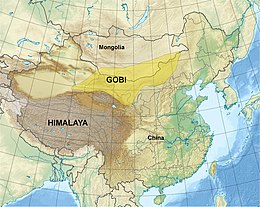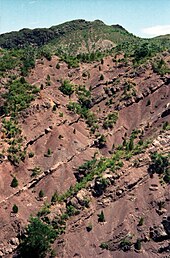China's Green Wall

Green Wall ( Chinese 绿色 长城 , Pinyin Lǜsè Chángchéng ) is a Chinese environmental project to prevent the desertification of the People's Republic . The official name for the project is Sanbei Fanghulin ( Chinese 三 北 防護林 / 三 北 防护林 , Pinyin Sānběi Fánghùlín , English Three-North Shelterbelt Development Program - "three-north protection forest", whereby 'three-north' means the regions northwest , North and Northeast China means).
The name of the project is derived from the parallel Great Wall . What they have in common is the protective function: while the great wall offered protection against the peoples from the north, the green wall is intended to hold back desert storms.
The Green Wall is the largest reforestation project ever undertaken . It is seen as the best way for China to stop the increasing devastation of entire regions. The dry north is particularly affected, but due to the size of the population it must remain habitable.
Desertification in China
In Beijing there are several alarms every year about impending breathing problems when a sandstorm from the north brings with it desert sand . This problem mainly affects the north, where the borders with the Chinese deserts are. As a result of desertification , the People's Republic loses an area of 2,500 km² (roughly the area of the Saarland ) every year . 100 million people are threatened by desertification. The average temperature in Beijing has already risen by a few degrees Celsius due to the desert heat . Even Japan , North Korea and South Korea are suffering from the dust storms from China, because they result in those countries to brown rain and clogged rivers. These sandstorms, which the Chinese also poetically call " yellow dragons ", are so powerful that dust from China has already been found on the west coast of the USA.
Causes of Desertification
As in many countries around the world, desertification is a result of human influence.
The rapidly increasing land use overwhelms the soil , as it deprives it of nutrients and changes the structure of the soil . Due to overgrazing and deforestation , the sparse vegetation decreases, the soil loses strength or is exposed without the protective layer of plants. Over time, the precipitation either wears away the top layer of soil ( humus layer ) or it dries out and is carried away by the wind ( deflation ; see also erosion ).
The industrialization shares responsibility. When the People's Republic was founded in 1949, 8% of the country's area was still forested. As a result of industrialization, the need for firewood increased, which was covered by increased deforestation.
Another problem is the increasing water consumption of industry , agriculture and the growing population . It is only made possible by new wells and dams , among other things . The consequences of this are a falling water level in the rivers - this can lead to the fact that the river runs dry before it flows into the sea - and a drop in the groundwater level . For example, China's second longest river, the Huang He ( Yellow River ), falls dry on its lower reaches and in the estuary for about half a year.
Project scope
The construction of the Green Wall began in 1978 and is to continue until 2050. By then, 350,000 square kilometers of land should be planted, an area the size of the Federal Republic of Germany .
The areas affected by desertification (including desert areas) cover around 2.6 million square kilometers and thus around 28% of the Chinese territory. That is more than seven times the area of Germany.
method

Forest is very suitable for reducing wind speeds and thus slowing down the erosion of the soil. Therefore, trees , bushes and grasses are to be planted in a protective belt through 14 provinces with a length of over 4,500 km and a width of several 100 km - a wall of forest. The trees slow the wind speed and hold up sand, the roots of the plants give the soil structure and strength and prevent the soil from being eroded. Very rapid growth and stability against the desert sand is important for the use of the plants, and that with only 100 to 200 mm of rain per year. Tamarisks and poplars , which are undemanding in terms of their environment and at the same time grow quickly, are particularly suitable. In the future, genetically modified or cloned poplars will also be planted.
Since monocultures are very susceptible to pest infestation and diseases , mixed forests should mainly be planted. But arable land is also part of the Green Wall.
The Chinese people are directly involved in the work: by law, every Chinese citizen between the ages of 11 and 60 is required to plant three to five trees per year. As an alternative to this, there is the option of paying a fee or a fine .
There are different possibilities of afforestation that are used: On the one hand, the sand dunes are leveled and fortified in a very traditional way with excavators and bulldozers . Then comes the planting, which is generally done by humans. On the other hand, there is the possibility of “ air seeding ”, which the Chinese developed through this project to market maturity. The seeds are dropped from an airplane . Wrapped in small clay balls ( seed bombs ), they make it through the first period of growth. So far, 1000 square kilometers (a little more than the area of the island of Rügen ) have been planted in this way.
Structural reform of forestry
In 2003, China started structural reform for forest operations. As a result of the reform, forest areas were leased to individual farmers and their rights were secured by documents. The tenants are now registered as owners of the trees that they planted themselves. In addition, they may cultivate the land under certain conditions or transfer their rights of use to other persons or companies. This structural reform of the forestry industry created an incentive for farmers to invest in tree planting.
successes
Protective forests were created in 13 provinces. They already cover an area of 220,000 square kilometers. This corresponds roughly to the area of Great Britain . The afforestation work has already been successful in some regions. Dried out areas, in which the residents had to clear their houses of sand every day, remain habitable, the effect of the sandstorms in these regions diminished.
Forests planted so far have already reduced the sand transport from storms by 200 million tons per year.
China's forest area has almost doubled since the 1990s. In the new millennium, a total ban on grazing was widely implemented in the endangered areas. Despite all efforts, the desert is still expanding in some areas. But between the years 2000 and 2004 the desertification area shrank for the first time annually by almost 1,300 square kilometers. That corresponds to the size of the urban area of Los Angeles .
China has a total of 1,750,000 square kilometers of forest (as of 2008) and thus the largest reforested forest areas in the world. More than 60 billion trees have been planted for this purpose since 1978 (as of 2016).
criticism
The Beijing branch of Greenpeace sees the "vitality of natural forests" in danger. It is criticized that the afforested trees are mainly non-native poplars and firs , which could lower the water table further. According to the local government of Ningxia , monocultures and poor soil quality make the trees susceptible to disease. The Asian long-horned beetle attacks, according to UN organization FAO , an estimated 500,000 hectares of green wall.
media
- China's green wall. Documentary, Germany, 2002, 43:30 min., Script and direction: Achim Kampmann, production: arte , Discovery Channel , series: 360 ° - Geo-Reportage, first broadcast: June 19, 2004 on arte ( table of contents by GEO ). Abridged version on Youtube.com .
Web links
- The great green wall. In: Telepolis , June 7, 2005
- Sand in the gears of the Chinese upswing. In: Deutsche Welle , June 9, 2006
- China's Great Green Wall. In: Telepolis , January 16, 2020
Individual evidence
- ↑ a b Guido Kuchelmeister: combating desertification in China. ( Memento from January 19, 2012 in the Internet Archive ) In: Entwicklung & rural space , 2006, No. 4, (PDF file, 4 pages).
- ↑ China.org.cn: A tamarisk researcher. , January 24, 2002.
- ↑ Ümüt Halik, TU Berlin : Planning and management of urban open spaces in Ürümqi. ( Memento from February 19, 2005 in the Internet Archive ) In: TU International , 46/47, December 1999, (PDF file, 4 pages).
- ↑ Esther Kahlen: Diploma thesis 2004 ( Memento of the original from May 19, 2006 in the Internet Archive ) Info: The archive link was inserted automatically and has not yet been checked. Please check the original and archive link according to the instructions and then remove this notice. , see chap. 1.5, p. 11, environmental problems (PDF file, 92 p.)
- ↑ Embassy of the People's Republic of China in Germany: China is one of the world's most active countries in terms of afforestation. , January 29, 2008.
- ↑ a b Quoted from Christoph Behrens: China's green army should stop the desert . In: Süddeutsche Zeitung , December 22, 2016, accessed on July 2, 2017.
Coordinates: 40 ° 0 ′ 0 ″ N , 109 ° 0 ′ 0 ″ E

